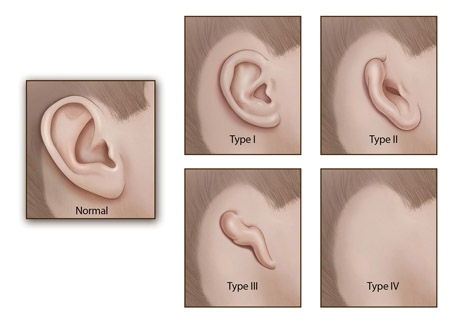Contact us
Call us today to schedule an appointment or to learn more about Microtia & Ear Canal Atresia.
Microtia is a congenital deformity of the outer ear where the ear does not fully develop during the first trimester of pregnancy. The word “microtia” means “little ear”, from the Latin words “micro” and “otia”. Microtia ears vary in appearance, and are usually smaller in size, often only consisting of a tiny peanut-shaped lobe. Microtia occurs about 1 in 5,000 births, though rates can vary depending on ethnic background. In 90% of cases, it affects only one ear, usually the right ear, and is more common in males. Microtia describes the outer ear, but is often associated with absence of the ear canal (called canal atresia or aural atresia), or an extremely narrow ear canal (canal stenosis).

In most cases, microtia is not genetically inherited. In 95% of children with microtia, there is no family history of microtia or other major ear anomalies in either the paternal or maternal side of the family. In the majority of cases, microtia appears to be a randomly occurring event or anomaly that happens during early development of the embryo. One child may be born with microtia where a twin sibling may not show any signs of having microtia.
In approximately 5% of cases, microtia can be familial with the condition present in multiple family members. Microtia can skip family generations, and one family member may have the right ear affected while another has the left ear affected. If you have a child with microtia, there is an estimated 5% increased risk of having another child with microtia. Likewise, the risk of a child with microtia eventually having a child of his/her own with microtia has been estimated to be 5%.
Most patients with microtia have no other significant medical problems aside from the ear. Approximately 50% have underdeveloped bony and soft tissues on the involved side of the face (hemifacial microsomia). Up to 15% can have varying degrees of facial nerve weakness. Other general abnormalities such as cleft lip or palate, cardiac, or urological problems are infrequently seen. Microtia is sometimes associated with other craniofacial syndromes, such as Treacher Collins Syndrome and Goldenhar Syndrome (oculoauriculovertebral dysplasia).
Microtia patients often have canal atresia (no ear canal) or canal stenosis (narrow ear canal). Patients with canal atresia or stenosis usually fail the newborn hearing screening, and must be referred to a pediatric audiologist for further diagnostic evaluation and discussion of auditory rehabilitative options.
In most cases the exact cause of microtia is unknown. As microtia is a rare condition, it is not often found on the prenatal ultrasound. Possible causes include:
Connect with us:
Download our App: